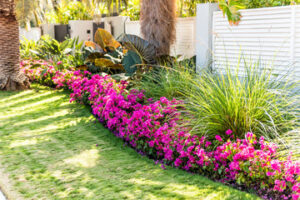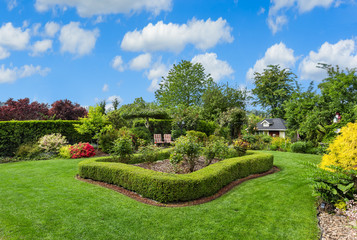If you’re new to landscaping, a little planning can help you avoid overworking yourself. Start with a few small projects that won’t break the bank.

Focal points add contrast and draw the eye towards specific areas of your landscape. They can be anything from trees to garden ornaments to water features. Contact Landscaping Greensboro NC for professional help.
Fertilizer adds essential nutrients like nitrogen (chemical symbol N), phosphorus (chemical symbol P) and potassium (chemical symbol K) to soil, helping grass grow taller and stronger, compete better with weeds and recover faster from environmental stress. Nitrogen promotes leafy growth and photosynthesis; phosphorus helps plants develop strong roots and shoots; and potassium encourages flowering and fruiting. Many natural and manufactured fertilizers are available in granular and liquid forms, enabling gardeners to choose the best one for their specific needs.
The type of fertilizer used depends on the season and the lawn’s grass type. Cool-season grasses like bluegrass and fescue should be fertilized in early spring and fall, while warm-season grasses such as Bermuda and zoysia need to be fed in late spring and summer. When choosing a fertilizer, match the nutrient levels to the recommendations on your soil test report. A fertilizer’s N-P-K ratio, which is listed on the label in the form of a percentage, indicates the proportion of each nutrient contained in the product.
In addition to the N, P and K that fertilizers provide, they also contain trace elements that are important for plant health. Organic fertilizers, which are made from a variety of natural materials, tend to have a higher proportion of these essential minerals than synthetic products. They also provide slow-release nutrients, which become available to the plant over time.
Both organic and inorganic fertilizers are available in quick-acting and slow-release forms. Organic options include a range of natural materials such as seaweed, blood fish and bone meal, manure and chicken manure pellets, while inorganic products are manufactured from chemically synthesized ingredients. Fast-acting synthetic options, such as Tomorite and Miracle-Gro All Purpose Concentrated Liquid Plant Food, are great for giving plants a boost when they need it.
While fertilizers are essential for healthy gardens, they can also contribute to pollution when applied incorrectly. For example, if too much is applied at once, it can leach out of the soil, contaminating storm drains and local waterways. Watering immediately after applying fertilizer can help the nutrients penetrate the soil, rather than washing away with runoff.
Native Plants
Planting native trees, shrubs, ground cover, flowering plants and ferns gives your landscape a sense of place. It also supports local wildlife by providing the food they need, habitat for shelter and protection from predators, and other resources such as berries and nectar. Native landscaping may seem like a difficult proposition for the average homeowner – after all, there aren’t many large, well-stocked commercial or residential nursery centers selling a variety of native ground covers, perennials and trees. But the truth is that you don’t have to go too far out of your way to find a wide selection of options to fit most any yard size or budget.
Native plants are those that naturally grow in a specific region, and they have adapted to environmental factors such as soil types, hydrology and micro-climates over time. Because of this, they need less attention to thrive – and they help conserve water and soil nutrients by reducing the amount of rainwater that is runoff or leaches into rivers and streams. This also saves on the cost of fertilizers and pesticides because the plants will be better able to naturally resist disease and other stresses.
In addition, native plants are more likely to attract pollinators such as bees, birds and butterflies. This is because they evolved with these creatures and provide the food they need. As a result, you can expect to see an uptick in the amount of honeybees, hummingbirds and other wild animals visiting your yard.
Native plants are an integral part of the modern movement toward sustainability and biodiversity. They can be used in residential, commercial and public spaces for their aesthetic beauty, environmental conservation, soil health and water conservation benefits. They can even be used to reduce the amount of chemicals and other contaminants that are deposited in waterways and soil through fertilizers, pesticides and other human influences. Fortunately, we now have the tools to make native landscaping easier and more affordable than ever.
Irrigation
Water is vital to life and a key component in growing lush, healthy lawns. But too much or too little can be devastating to your landscaping. Irrigation systems provide regulated amounts of water at the right time for optimal growth. Using irrigation to water your plants and shrubs ensures your lawn is healthy, green, and beautiful.
An irrigation system can help to save you money on your utilities. By using a system that provides precise and efficient watering, you can reduce your water bill significantly. These systems use advanced features like rain sensors, smart controllers, and drip irrigation to ensure your property receives the proper amount of water each week.
A good irrigation system can make your property look amazing and increase your home’s value. In addition, it can reduce the need for manual watering which is an inefficient and time-consuming process. If you are considering having a professional irrigation system installed on your commercial property, contact Groundscapes today.
Irrigation systems are set up in zones, allowing different areas of your property to get the appropriate amount of water for each type of grass and plant. Unlike one-size-fits-all sprinkler kits bought at a hardware store, these systems are customized for your property to avoid watering any dead areas of your yard. They also come with features that prevent your system from turning on while it’s raining or after it has recently rained, ensuring you don’t waste water or overwater your landscape.
Irrigation helps with soil water storage by allowing the soil to absorb moisture in the correct ratios for each species and soil type. The rate at which the soil absorbs water influences the whole growth process from seedbed preparation, germination, root growth, nutrient utilization, plant development and regrowth, yield, and quality.
A well-maintained irrigation system can help prevent drought conditions. In regions with dry climates, irrigation systems should be adjusted to provide water at a lower frequency. Irrigation systems should also have rain sensors to prevent overwatering and runoff. Fortunately, irrigation technology has evolved to provide options that are more efficient and economical than ever before.

